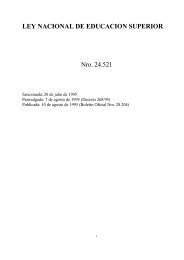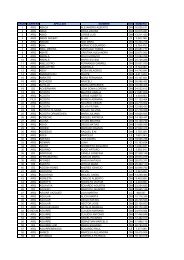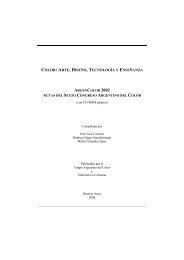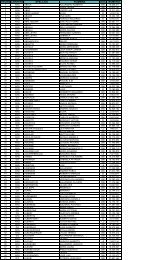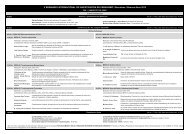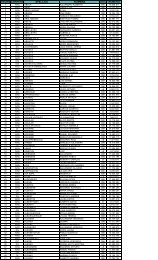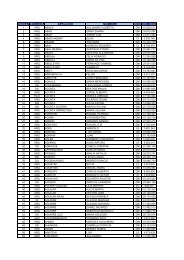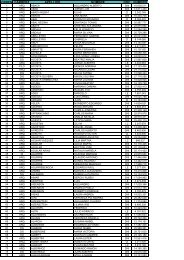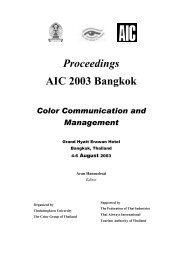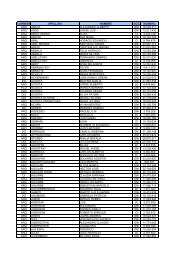Light as a genetic element of the image
Light as a genetic element of the image
Light as a genetic element of the image
Create successful ePaper yourself
Turn your PDF publications into a flip-book with our unique Google optimized e-Paper software.
AIC 2004 Color and Paints, Interim Meeting <strong>of</strong> <strong>the</strong> International Color Association, Proceedings<strong>Light</strong> <strong>as</strong> a <strong>genetic</strong> <strong>element</strong> <strong>of</strong> <strong>the</strong> <strong>image</strong>Fernanda GARCÍA GIL, Ana GARCÍA LÓPEZ, Gertrudis ROMÁN JIMÉNEZ, Sara TEVAALMENDROS, and Teresa VIDA SÁNCHEZResearch Group HUM-480 <strong>of</strong> <strong>the</strong> Junta de Andalucía“Constitución e Interpretación de la Imagen Artística” (Constitution and Interpretation <strong>of</strong> <strong>the</strong>Artistic Image)In this paper we will try to syn<strong>the</strong>size <strong>the</strong> cultural references and <strong>the</strong> b<strong>as</strong>is <strong>of</strong> art languageswithin <strong>the</strong> 20 th century. That will make evident <strong>the</strong> evolution <strong>of</strong> colour <strong>as</strong> main character in<strong>the</strong> work <strong>of</strong> art. This way, we intend to contr<strong>as</strong>t modernity and posmodernity periods in <strong>the</strong>way colour studies are organized. We can find different arrangements on this matter.Colour studies are relevant for structuralist <strong>the</strong>ories that limit and put language in order.Thereby, compositions and art works in that period are defined just to overvalue structures (toimply space but without plainly talk about it, with <strong>the</strong> exception <strong>of</strong> some forms <strong>of</strong> sculptureand architecture) that best attend colour, form and texture.Starting from <strong>the</strong>se data, a deep change on <strong>image</strong> construction is shown, and <strong>the</strong>refore, alsoon <strong>the</strong> construction <strong>of</strong> pl<strong>as</strong>tic and visual languages. On that setting, colour is placed within aconstant enrichment system, in which all <strong>element</strong>s feed each o<strong>the</strong>r and <strong>the</strong> links among<strong>genetic</strong> <strong>element</strong>s remain opened.Conceptual art stresses <strong>the</strong> evidence <strong>of</strong> <strong>the</strong> inseparable link between ide<strong>as</strong> andmaterializations in artistic creation.Minimal art lays <strong>the</strong> open <strong>image</strong> constitution system bare. This is capable <strong>of</strong> joiningmodernity dominating <strong>element</strong>s (compositive structure: colour-form-texture) with those<strong>element</strong>s that first originated <strong>the</strong>m (space-time-light-matter).Some artists’ pieces <strong>of</strong> art accentuate <strong>the</strong> significant sense <strong>of</strong> physical <strong>as</strong> well <strong>as</strong> <strong>the</strong>perceptive and receptive experience. Those pieces re-significate <strong>the</strong> <strong>genetic</strong> <strong>element</strong>sshowing, this way, <strong>the</strong> intimate indissoluble relationship between <strong>the</strong> dominant <strong>element</strong>s inmodernity and those rediscovered to be main characters in artistic movements; that, in <strong>the</strong>o<strong>the</strong>r hand, will lead to posmodernity, <strong>as</strong> shown in <strong>the</strong> graphics attached.<strong>Light</strong> is set to be <strong>the</strong> space and surfaces descriptor within natural world system <strong>of</strong> things.Also describes manipulated spaces and objects systems within artificial world. <strong>Light</strong>evidences matter bounds in every forms and possible variations. And is precisely its contactwith matter that causes <strong>the</strong> receptor <strong>the</strong> sensation <strong>of</strong> colour when absorption-reflectionphenomena occur.Qualities on matter surfaces will be shown depending on a certain light incidence angle. InModernity time, those qualities have been taken <strong>as</strong> texture. Texture h<strong>as</strong> come to enrich <strong>the</strong>influence <strong>of</strong> this perceptive appreciation with colour appraisal, being both sensations different<strong>as</strong>pects <strong>of</strong> light-matter-space-time treatment <strong>as</strong> a world knowledge experience.For artists’ work, light turns from a p<strong>as</strong>sive <strong>element</strong> into an active and determinant one for<strong>the</strong> consecution <strong>of</strong> <strong>the</strong>ir pieces <strong>of</strong> art. Therefore, a new implementation in art languagesstudies is needed <strong>as</strong> a strategy to feature and evaluate pieces <strong>of</strong> artwork within this new point<strong>of</strong> start. At <strong>the</strong> same time, we have to say that most art academies pedagogical programs areimmerse in a period in which colour sensations should be studied, never more in <strong>the</strong> margin<strong>of</strong> light and limited matter, but <strong>as</strong> a whole with <strong>the</strong> rest <strong>of</strong> <strong>genetic</strong> <strong>element</strong>s.In this set <strong>the</strong> Research Group HUM-480 “Constitución e Interpretación de la ImagenArtística” h<strong>as</strong> been working for a long time within <strong>the</strong> work <strong>of</strong> art perception research area.265
AIC 2004 Color and Paints, Interim Meeting <strong>of</strong> <strong>the</strong> International Color Association, ProceedingsWe have paid special attention to <strong>the</strong> so-called <strong>genetic</strong> <strong>element</strong>s <strong>of</strong> <strong>the</strong> artistic <strong>image</strong>: light,matter, space and time, where colour remains <strong>as</strong> an important <strong>element</strong> in <strong>the</strong> artistic language.At <strong>the</strong> beginning <strong>of</strong> March 2004, a <strong>the</strong>oretical-practical seminar w<strong>as</strong> carried out with <strong>the</strong>Buenos Aires National Institute <strong>of</strong> Art pr<strong>of</strong>essor Mauricio Rinaldi, which also works in <strong>the</strong>lighting area for <strong>the</strong> Colon Theatre <strong>of</strong> Buenos Aires, Argentina, and is a relevant member <strong>of</strong><strong>the</strong> Argentine Colour Group. The seminar w<strong>as</strong> called “<strong>Light</strong>ing in Art and Stage Design”.In this seminar, <strong>the</strong> light work w<strong>as</strong> treated from a b<strong>as</strong>ically technical point <strong>of</strong> view (electricsystems, power ph<strong>as</strong>e and distribution, external-internal knowledge about different spotlightsand mixing-light desks, etc.) to a special focus on <strong>the</strong> significance, that is, not just on <strong>the</strong> howbut on <strong>the</strong> why to use a certain lighting sketch. Aes<strong>the</strong>tics <strong>of</strong> light and communication <strong>the</strong>orieswere also analysed, to come up with <strong>the</strong> consideration <strong>of</strong> light <strong>as</strong> a communication <strong>element</strong>inside <strong>the</strong> object <strong>of</strong> art, <strong>as</strong> well <strong>as</strong> stage design or pl<strong>as</strong>tic arts.The experience <strong>of</strong> working with 49 students w<strong>as</strong> very interesting. They made very complexnarrative pieces <strong>of</strong> artwork, in which light w<strong>as</strong> considered part <strong>of</strong> <strong>the</strong> communicative exercise.The above-specified members <strong>of</strong> <strong>the</strong> research group have developed a communication aboutthis experience. The importance <strong>of</strong> this research lies on <strong>the</strong> integration <strong>of</strong> <strong>the</strong> <strong>Light</strong> andMaterials Laboratory 1 into <strong>the</strong> Faculty <strong>of</strong> Fine Arts <strong>of</strong> Granada University teaching practice.Images <strong>of</strong> this experience show <strong>the</strong> sequence and changes <strong>of</strong> paradigm in visual languagesconfiguration. The relationship <strong>of</strong> light and matter not only shows colour but o<strong>the</strong>r verycomplex and richness phenomena that take part in <strong>the</strong> construction <strong>of</strong> <strong>image</strong>s. That is, <strong>the</strong>opacity and translucency contr<strong>as</strong>ts, different reflection stages that will indicate significant<strong>as</strong>pects and introduce matter blendings in matter structure surfaces, etc.The work <strong>of</strong> <strong>the</strong> Research Group HUM-480 studies this open systems <strong>of</strong> <strong>genetic</strong> <strong>element</strong>sthat are articulated <strong>the</strong>mselves within <strong>the</strong> appearance system. The relationship <strong>of</strong> light andmatter <strong>as</strong> an actual specific space-time experience, in which <strong>the</strong>y are configured within ageometry that evidences <strong>the</strong> complexity and richness <strong>of</strong> <strong>image</strong>s construction. These <strong>image</strong>sare not possible without a reception; in <strong>the</strong> same way colour sensation would not occurwithout a receptor that should eventually transmute <strong>the</strong> reflected radiation into coloursensation.A new scope <strong>of</strong> development is happening in visual and pl<strong>as</strong>tic art:Artists whose art works are in re-definition and making wide new strategies in artlanguage.Open interpretation systems in a hermeneutic key: materializations, referential and virtual<strong>image</strong>s. Senses or real interpretations. Senses or referential interpretations. Slidings andtransgressions, etc.Redefinition <strong>of</strong> nature mute language into pl<strong>as</strong>tic and visual <strong>image</strong>s language:interpretative projection. Constructive projection. Pedagogical projection.From art, <strong>the</strong> relevance on <strong>the</strong>se studies set <strong>the</strong> b<strong>as</strong>is on visual languages, <strong>the</strong> narration bymeans <strong>of</strong> which we understand and create worlds.1 The <strong>Light</strong> and Materials Laboratory is a creative and technical research project with <strong>the</strong> purpose <strong>of</strong>integration in <strong>the</strong> new syllabus <strong>of</strong> <strong>the</strong> Faculty <strong>of</strong> Fine Arts studies.266
AIC 2004 Color and Paints, Interim Meeting <strong>of</strong> <strong>the</strong> International Color Association, ProceedingsNext, we will show some artists’ work that can exemplify all what h<strong>as</strong> been exposed.Björn Dahlen: Club Superspace 3, Charm-Sphären(Deuterium Attezione), installation’s view.Kunstverein in Hamburg, 2001. Andrómeda, wood,neon and mixed media, 1999. Artist, sculptor andstage designer born in 1974 in Munich, Dahlenworks in Berlin. The installations retain <strong>the</strong> spirit <strong>of</strong>arte povera because <strong>of</strong> <strong>the</strong> austerity and simplicity<strong>of</strong> his work. Materials used: neon tubes, wood, video monitors. S<strong>of</strong>t techno lighting, romanticor multicolour, reflects intersideral space recalling <strong>the</strong> galactic myth by means <strong>of</strong> light.Martin Creed: Work Nr. 227, <strong>the</strong> light in a room going on and <strong>of</strong>f,frequency every 5 seconds, variable material and dimension, 2000. Thisartist uses gallery room <strong>as</strong> container and me<strong>as</strong>urement unity. Born in 1968in England, he lives and works in Italy. He uses light <strong>as</strong> modelling<strong>element</strong> in <strong>the</strong> exhibition space. The room is empty and <strong>the</strong> normalillumination is substituted with intermittent lighting that blinks in fivesecondgaps. With this minimalist installation <strong>the</strong> artist catches <strong>the</strong>attention over physical space through <strong>the</strong> play <strong>of</strong> light.Carsten Höller: <strong>Light</strong> wall, installation’s view, Prada Foundation, Milan,2000. This artist creates a successful combination <strong>of</strong> art and science. Hetries to wide and spread <strong>the</strong> boundaries <strong>of</strong> human perception, searchingpsychological sensations. If we want to open our perceptive horizon, weshould give up our habits and certainties. In this piece <strong>of</strong> art, 1920 bulbsemitted light and heat, switching on and <strong>of</strong>f in a 7,8 Hz. frequency g<strong>as</strong>p.Even with <strong>the</strong>ir eyes shut, <strong>the</strong> spectators could not hide from light. Brain iscompared to an electric system that synchronizes external impulses.267
AIC 2004 Color and Paints, Interim Meeting <strong>of</strong> <strong>the</strong> International Color Association, ProceedingsJacques Herzog and Pierre De Meuron: Goetz Collection, Munich,1992. This is an exhibition gallery. At a first glance it might recall<strong>the</strong> structural clarity and functionality <strong>of</strong> pieces by Mies van derRohe, but a deeper analysis reveals a more complex and uncertaincharacter. Distance between apparent and real is shown also in <strong>the</strong>building structure. The rhythmical division that <strong>the</strong> supportingvertical <strong>element</strong>s produce, call for diagrammatical clarity inrationalism. The upper and lower floor feature light in <strong>the</strong> way <strong>of</strong> <strong>as</strong>kylight.Norman Foster & partners: Centre <strong>of</strong> Industrial Promotion,Duisburg, Germany, 1993. We can watch light andarchitecture joining in a perfect way. This new city councilpromotion central <strong>of</strong>fice intends to be emblematic <strong>of</strong>German region Ruhr new economical revitalisation. Thisbuilding is sited in microelectronics Park, also by Foster,which is composed by a group <strong>of</strong> buildings set downtown.The Promotion Centre is gl<strong>as</strong>s coated over <strong>the</strong> concretestructure. This makes light to reflect outside <strong>as</strong> a screen. Ifwatched at night, with its blinds open, this building gl<strong>as</strong>soutside wall h<strong>as</strong> a minimalist interpretation. In daylight, <strong>the</strong>shinning closed blinds <strong>of</strong>fer an appearance <strong>of</strong> a reflectingand opaque frontage. Foster’s modernism exemplifies <strong>the</strong>use <strong>of</strong> light <strong>as</strong> <strong>the</strong> main character in architectural design.Friedrich Förster and Sabine Weissinger: The Magic House. These artists have developed atechnique in which big slide <strong>image</strong>s are projected over huge surfaces. They have beendeveloping this technique since <strong>the</strong> eighties and have come up with a computer b<strong>as</strong>ed controlsystem. This way <strong>image</strong>s can be manipulated to fit <strong>the</strong> building structure and dimensions. One<strong>of</strong> <strong>the</strong> main characteristics <strong>of</strong> <strong>the</strong> Magic House project is that integration between buildingand aes<strong>the</strong>tic design projection is perfect. Building façade turns constantly into differentconceptions according with <strong>the</strong> topic related, changing from dynamic moving <strong>image</strong>s withsound to those slow track changing static ones. “Our main target is not just to illuminatebuildings, but to enhance its architectonic, historical and aes<strong>the</strong>tical values, <strong>as</strong> well <strong>as</strong> <strong>the</strong>same place where <strong>the</strong>y are set”, says Förster. Building artistic lightening and projecting is ayoung gender within <strong>the</strong> art practices. Förster and Weissinger illuminated <strong>the</strong> inner spaces inCologne St. Peter’s gothic ca<strong>the</strong>dral, accepting <strong>the</strong> challenge <strong>of</strong> lightening <strong>the</strong> second biggestgothic ca<strong>the</strong>dral in <strong>the</strong> world. After <strong>the</strong> sunrise, <strong>the</strong> Magic House spectacle started when 6huge projectors were switched on inside <strong>the</strong> ca<strong>the</strong>dral. Projected light over walls, vaults, highaltar and columns would show <strong>image</strong>s <strong>of</strong> architectural composition taken from <strong>the</strong> samebuilding: tessellated pavement, tracery and stained-gl<strong>as</strong>s windows... Images changed speedfrom a slow star rain to a quick flow <strong>of</strong> <strong>image</strong>s turning colours and shapes. The spectatorperceives a sudden sensation <strong>of</strong> sliding walls, rotating columns and that <strong>the</strong> whole churchstarts to move. Movements are s<strong>of</strong>t, though, and invite <strong>the</strong> audience to enjoy <strong>the</strong> show andthink over life, colour, movement... “We search for a 3D sensation with our projections sothat we can provide <strong>the</strong> inner spaces with life”, says Förster.268
AIC 2004 Color and Paints, Interim Meeting <strong>of</strong> <strong>the</strong> International Color Association, ProceedingsView <strong>of</strong> <strong>the</strong> interior <strong>of</strong> <strong>the</strong> Cologne ca<strong>the</strong>dral, Germany.Friedrich Förster and Sabine Weissinger: The Magic House, LichtRaum Dom. View for <strong>the</strong>Chorfestival 2004 in Germany.Address: Fernanda García Gil, Depto. de Pintura, Facultad de Bell<strong>as</strong> Artes, Universidad deGranada, Av. de Andalucía s/n, Edificio Aynadamar, 18071 Granada, SpainE-mails:269



